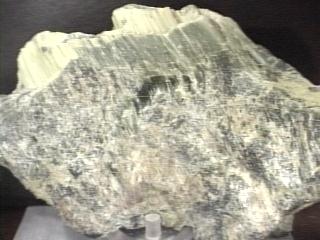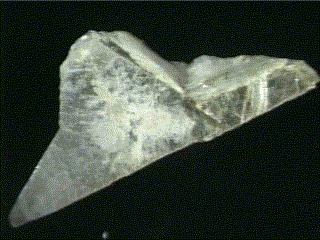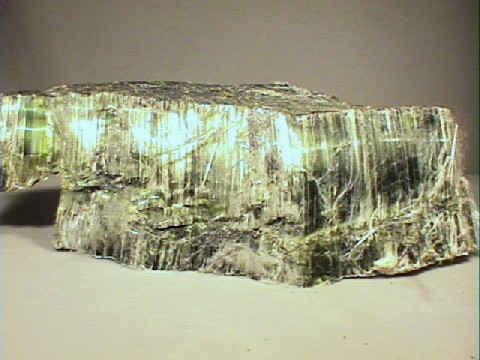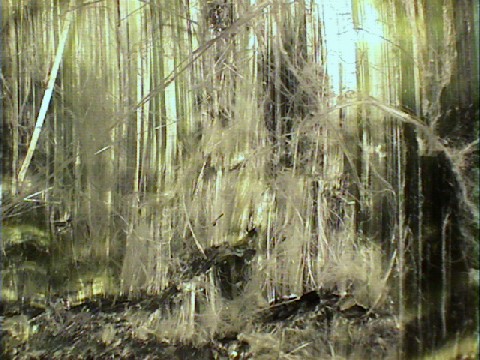 THE MINERAL SERPENTINE
THE MINERAL SERPENTINE
- Chemistry: (Mg,Fe)3Si2O5(OH)4, Magnesium Iron Silicate Hydroxide
- Class: Silicates
- Subclass: phyllosilicates
- Group:
Kalolinite-Serpentine - Uses: many industrial applications, including brake linings and fireproof fabrics and as an ornamental stone.
Specimens
Serpentine is actually a general name applied to several members of a polymorphic group. These minerals have essentially the same chemistry but different structures. The following is a list of these minerals, their formulas and symmetry class:
- Antigorite; (Mg,Fe)3Si2O5(OH)4; monoclinic.
- Clinochrysotile; Mg3Si2O5(OH)4; monoclinic.
- Lizardite; Mg3Si2O5(OH)4; trigonal and hexagonal.
- Orthochrysotile; Mg3Si2O5(OH)4; orthorhombic.
- Parachrysotile; (Mg,Fe)3Si2O5(OH)4; orthorhombic.
Serpentine's structure is composed of layers of silicate tetrahedrons linked into sheets. Between the silicate layers are layers of Mg(OH)2. These Mg(OH)2 layers are found in the mineral brucite and are called brucite layers. How the brucite layers stack with the silicate layers is the main reason for the multiple polymorphs. The stacking is not perfect and has the effect of bending the layers. In most serpentines, the silicate layers and brucite layers are more mixed and produced convoluted sheets. In the asbestos varieties the brucite layers and silicate layers bend into tubes that produce the fibers.
Serpentine can be an attractive green stone that takes a nice polish and is suitable for carving. It has been used as a substitute for jade and is sometimes difficult to distinguish from jade, a testament to the beauty of finer serpentine material.
Non-fiberous serpentine is not a cancer concern. Asbestos serpentines should be kept in closed clear containers, but makes an attractive specimen. Sometimes with a golden color as the name chrysotile in greek means golden fibers.
PHYSICAL CHARACTERISTICS:
- Color is olive green, yellow or golden, brown, or black.
- Luster is greasy, waxy or silky.
- Transparency crystals are translucent and masses are opaque.
- Crystal System is variable, see above.
- Crystal Habits: never in large individual crystals, usually compact masses or fibrous. Veins of viberous serpentine can be found inside of massive serpentine or other rocks.
- Cleavage the varieties of crysotile have none, in lizardite and antigorite it is good in one direction.
- Fracture is conchoidal in antigorite and lizardite and splintery in the crysotiles.
- Hardness is 3 - 4.5
- Specific Gravity is 2.2 - 2.6
- Streak white
- Associated Minerals include chromite, olivine, garnets, calcite, biotite and talc.
- Other Characteristics: serpentine in the rough has a silky feel to the touch and fibers are very flexible.
- Notable Occurances Val Antigorio, Italy; Russia; Rhodesia Switzerland; North Carolina, California, Rhode Island and Arizona, USA and Quebec, Canada.
- Best Field Indicators softness, color, silky feel and luster, asbestos if present and its flexibility.









